December 31st, 2013
 Compassion typically involves the recognition of someone else’s suffering on both an intellectual and emotional level and a real attempt to address or alleviate it. Acts of compassion are widespread ranging from one friend consoling another about a loss, or an oncologist coaching a cancer patient to a relief organization striving to help an entire community struck by a natural disaster.
Compassion typically involves the recognition of someone else’s suffering on both an intellectual and emotional level and a real attempt to address or alleviate it. Acts of compassion are widespread ranging from one friend consoling another about a loss, or an oncologist coaching a cancer patient to a relief organization striving to help an entire community struck by a natural disaster.
Compassion is about helping others in an emotionally connected way. We expect compassion to happen naturally but sometimes it is difficult to make the emotional connection and keep your balance especially if you are exposed to intense suffering on a regular basis. Think about about acute healthcare for example. On the other hand, acts of compassion can naturally generate tremendous energy for positive transformational change. Consider the success of Mothers Against Drunk Drivers for example.
Understanding the psychology of compassion can be useful in many cognitive design challenges so I am always on the lookout for scientific studies with practical insights. Take for example, the recent research by the University of Rochester Medical Center, What Does Compassion Sound Like? They completed a study of how doctors talk with patients in a compassionate way looking for language use and behaviors that defines the experience. The researchers looked at tone of voice, humor, non-verbals, pauses, sights and a wide-range of other factors. Their general conclusion is important:
“It became apparent that compassion is not a quality of a single utterance but rather is made up of presence and engagement that suffuses an entire conversation,”
The implications for designers or anyone seeking to improve compassion-driven experiences is clear. Compassion frames the entire experience and unfolds during the course of the interaction.

Posted in Psychographics | No Comments »
December 24th, 2013
 Most adults have watched thousands of hours of movies. I’ve often wondered how that impacts long-term memory. Do the movie memories mix with the real-world memories and change how we interpret the world, learn and make important decisions and judgments? I bet it does, big time, but I have not been able to find any detailed studies of the effects.
Most adults have watched thousands of hours of movies. I’ve often wondered how that impacts long-term memory. Do the movie memories mix with the real-world memories and change how we interpret the world, learn and make important decisions and judgments? I bet it does, big time, but I have not been able to find any detailed studies of the effects.
I did recently see a study on how taking photographs of an object can impact memory for the object. According to point-and-shoot memories, if you take a picture of an entire object you are less likely to remember details about it. However, if you zoom in on a part of the object and take a photo of the details, your memory is unaffected. The study concludes:
“This finding highlights key differences between people’s memory and the camera’s “memory” and suggests that the additional attentional and cognitive processes engaged by this focused activity can eliminate the photo-taking-impairment effect.”
With cameras in our phones and popular ways of manipulating sharing photos (e.g. Facebook, Instagram, Flickr, Pic Stich, and Pinterest) camera memories are becoming a significant part of our Next Brain.
Sourced from the Next Brain Blog

Posted in Memory | 6 Comments »
December 20th, 2013

Being an effective workplace coach means you understand how people’s minds work especially when they learn and change. That’s the focus of a powerful new coaching program being offered in the learning and organizational change program at Northwestern. You will:
“Look deeply at the theory and practices behind learning and human performance in organizational settings while building a consulting “toolkit” that will help you be a more effective change leader.”
To earn a certificate you need to complete four courses. You can do that in a year from anywhere in the US. The program begins in March 2014 and there are two virtual information sessions in January.
If there is one coaching program I can recommend for cognitive designers this is it!
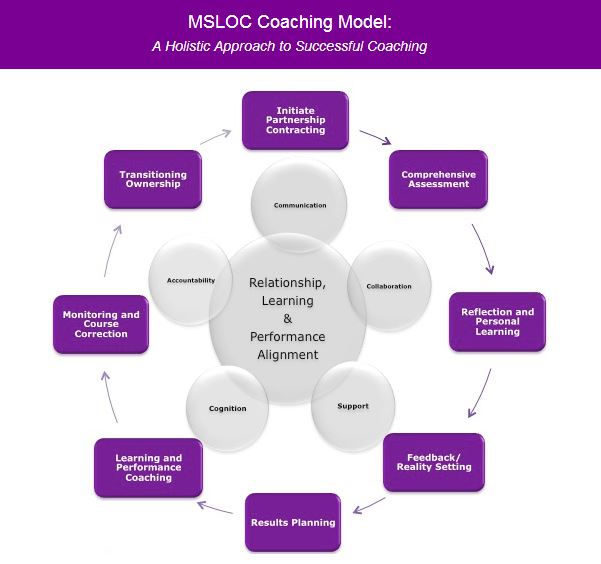

Posted in Events, Related Fields | 14 Comments »
December 15th, 2013
Metaphors play an important role in learning, communication, creativity, decision-making and all nearly all of our mental processes. Metaphors are a power tool for cognitive designers.
They are a window in how our minds are actually working and when properly designed they can shift behaviors and bring cognitive performance to new levels.
That’s why I am always on the lookout for new scientific results on cognition and metaphors.
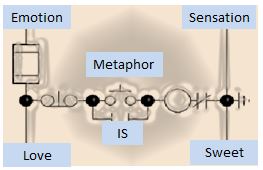 Take for example the article, What do love and jealously taste like? just published in the journal Emotion. Interestingly, the researchers found that those primed for the emotion of love reported that water tasted sweeter than normal or when they are primed for another emotion such as jealously or happiness. This provides some evidence that the metaphor “Love is sweet” impacts our perception of taste. Another case of expectations and psychology shaping senses and physiology.
Take for example the article, What do love and jealously taste like? just published in the journal Emotion. Interestingly, the researchers found that those primed for the emotion of love reported that water tasted sweeter than normal or when they are primed for another emotion such as jealously or happiness. This provides some evidence that the metaphor “Love is sweet” impacts our perception of taste. Another case of expectations and psychology shaping senses and physiology.

Posted in Metaphors, Psychographics | 3 Comments »
December 10th, 2013
In cognitive design we create artifacts that are optimized for how minds really work. There are five types of “minds” that are important in cognitive design.
- Individual (between the ears) including mental processes and structures in a given person’s brain.
 Extended (in the hand) including objects that we think, learn and create with. For example, an artist’s favorite paint brush or an architect’s model of a building.
Extended (in the hand) including objects that we think, learn and create with. For example, an artist’s favorite paint brush or an architect’s model of a building.- Group (among the heads) including any collection of individuals. For example, a partnership, product development team or therapy group.
- Machine (in a black box) including hardware and software that automates one or more mental processes or structures. For example, the buzzer on your clothes dryer or an expert system a car mechanics uses to diagnosis a problem.
- Emergent (beyond the heads) including a group and/or machine intelligence the delivers a new mental state or level of performance. For example, a prediction market that forecasts a presidential election or the success of a new product better than any individual.
A robust design seeks to distribute cognitive load across the five types of mind. In some applications we look to off-load the mental work that individuals have to shoulder on to groups or machines. In other cases we look to boost mental capacity by creating machine or extended minds that outperform individual or group minds in an important way.
For example, Wikistrat is an example of how to use an emergent mind effects to outperform a group of highly trained individuals. They are using gamification and crowdsourcing to produce high quality reports and forecasts on complex geopolitical and economic issues 5 times faster and for 1/3rd the price of traditional consultancies.
The architecture that creates the emergence is similar to massively multiplayer online games. Wikistrat assembles a group of analysts to develop scenarios for a client’s strategic challenge and then lets gamification kick in:

The chief analyst synthesizes the results and the client has access to all the intelligence via an interactive platform.
Definitely a new way to support the cognitive work needed to generate strategic insights into economic and geopolitical issues.

Posted in Augmented Cognition, Service Innovation | 14 Comments »
December 3rd, 2013
I get a good number of calls and emails from people wondering what cognitive design can do to help meet the challenge of improving engagement in high-quality science, technology, engineering and mathematics (STEM) education. The concern is, at least in the US, that enrollment is down just when we need more STEM educated citizens to innovate and compete in the global economy.
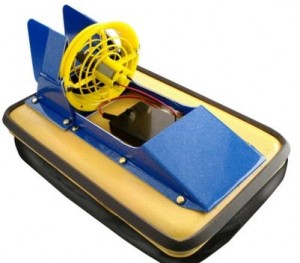 Teaching is a hard cognitive design challenge, especially teaching STEM so I generally have a lot of advice to share. Indeed, I have been teaching a physics class to learn more first-hand and experiment with specific cognitive design ideas. One suggestion I often make is create/buy and give cool science toys.
Teaching is a hard cognitive design challenge, especially teaching STEM so I generally have a lot of advice to share. Indeed, I have been teaching a physics class to learn more first-hand and experiment with specific cognitive design ideas. One suggestion I often make is create/buy and give cool science toys.
Technical play, often early in life, appears to be a common theme among STEM professionals that are making notable contributions to our economic prosperity.
For a sample across age ranges check out – science is creative and good toys reflect that. The idea is simple. Play by adults or children reveals the magic and power of science and will inspire us to learn more.
Interested to hear from readers that have experience with science toys.

Posted in Service Innovation | 7 Comments »
November 26th, 2013
It is now well known, and to some degree accepted, that specific types of cognitive biases can have a big impact on our decision making process. For example, the recency effect suggests that we give too much weight to the last paper we read or presentation we hear. Or the gambler’s fallacy that “someone must win” leads to all manner of distorted decisions and investments. There are literally hundreds of such biases that warp (from the perfectly rational) our decision-making processes on everything from buying a lottery ticket to deciding on a career.
 An interesting HBR post on Managing Atmospherics in Decision Making, takes it one step further. The author, Rob Duboff, argues that our decision-making process is influenced by a host of external factors such as color, music, appeal to authority and priming that he calls atmospherics. To quote:
An interesting HBR post on Managing Atmospherics in Decision Making, takes it one step further. The author, Rob Duboff, argues that our decision-making process is influenced by a host of external factors such as color, music, appeal to authority and priming that he calls atmospherics. To quote:
”It’s not just that decision-makers don’t refer to data in making choices – they don’t even necessarily decide based on “gut feel.” Decisions are being made because of external and seemingly extraneous factors that work on a wholly unconscious level, bypassing even the gut.”
This is important for cognitive designers because it shifts the focus of attention from “the gut” or the realm of cognitive biases to external factors.

Posted in Cognitive Bias, Psychographics | 3 Comments »
November 11th, 2013
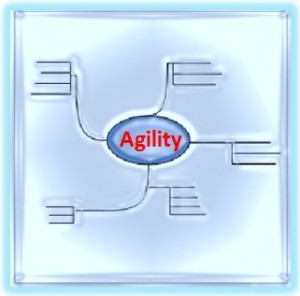 The Management Innovation Exchange (MIX) in cooperation with the Chartered Institute of Personnel and Development (CIPD) recently conducted a hackathon involving some 1700 HR professionals and business leaders aimed at cracking the code on agility. They released a report that summarizes nearly a 150 ideas organized into 9 design principles ranging from experimentation and learning to purpose and meaning. Nearly all of the design principles involve individual or group cognition and should be of interest to readers of the cognitive design blog.
The Management Innovation Exchange (MIX) in cooperation with the Chartered Institute of Personnel and Development (CIPD) recently conducted a hackathon involving some 1700 HR professionals and business leaders aimed at cracking the code on agility. They released a report that summarizes nearly a 150 ideas organized into 9 design principles ranging from experimentation and learning to purpose and meaning. Nearly all of the design principles involve individual or group cognition and should be of interest to readers of the cognitive design blog.
For example, one idea to is facilitate corporate earthquakes:
“The Corporate Earthquakes hack is all about crafting and anticipating an organization’s future by envisioning the unthinkable nightmares and dreams of tomorrow. This is done by designing and running corporate-wide hackathons focused on extreme, unusual, apocalyptic and why-not challenges and situations. The process is designed to be fun and inspire creativity, with possible corporate earthquakes including everything from likely industry shifts to unlikely events like mass alien abductions. “

Posted in Events, Related Fields | 3 Comments »
November 4th, 2013
 How we use our bodies impacts our thinking, learning, decision-making and other cognitive functions. The entire field of embodied cognition is devoted to understanding how body behaviors and mental performance interact. For example, literally “stepping back”, folding your arms or walking around have all been shown to improve problem solving outcomes.
How we use our bodies impacts our thinking, learning, decision-making and other cognitive functions. The entire field of embodied cognition is devoted to understanding how body behaviors and mental performance interact. For example, literally “stepping back”, folding your arms or walking around have all been shown to improve problem solving outcomes.
Findings in embodied cognition are especially relevant for designers because they tell you what people should do to produce specific mental states. So I am always on the look out for new scientific finding in embodied cognition. Take for example the recent work at the University of Cologne on hand washing.
Not only did they find that it tends to make you more optimistic after a failure, but they found that it leads to poorer performance in the same context.
This is a strange result as we normally associate optimism with higher levels of performance. Here is the explanation:
“… it can be concluded from the results that while physical cleansing after failure may eliminate negative feelings, it reduces the motivation to try harder in a new test situation to restore one’s own perception of competence. Hence, physical cleansing seems to result in being in a better position to deal with failure.”
Clearly more research is needed but it does bring to mind the old metaphor or saying: I am washing my hands of this situation.

Posted in Related Fields | 2 Comments »
October 28th, 2013
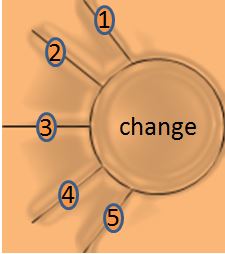 To make change stick you must over determine the outcome you want. That means applying many strategies and tools to the job rather than just one or a few. You need to find ways to tap intrinsic motivation, rewards, peer pressure and environmental factors if you want to change individual and group behaviors.
To make change stick you must over determine the outcome you want. That means applying many strategies and tools to the job rather than just one or a few. You need to find ways to tap intrinsic motivation, rewards, peer pressure and environmental factors if you want to change individual and group behaviors.
While this may seem like over kill to some, research supports the over determined approach to change. For example, a Sloan Management Review article, How To Have Influence, found organizations that used 4 or more strategies to drive a change where 10x more likely to achieve the outcomes they wanted. For a more general argument about the need to over determine your change effort check out Influencer: The New Science of Leading Change.
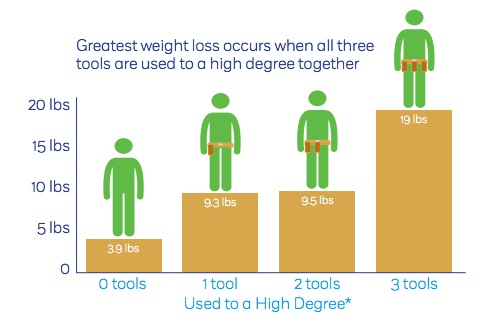 You see similar results in the personal behavior change space. For example, Baylor College of Medicine conducted a study that showed people that used more tools to lose weight achieved a greater loss. It was not a 10X effect but it was a 5X effect varying from 4 pounds for zero tools (self directed) to 20 pounds for those using three tools (weight watchers program, apps, etc.).
You see similar results in the personal behavior change space. For example, Baylor College of Medicine conducted a study that showed people that used more tools to lose weight achieved a greater loss. It was not a 10X effect but it was a 5X effect varying from 4 pounds for zero tools (self directed) to 20 pounds for those using three tools (weight watchers program, apps, etc.).
So the questions is not so much what are you going to do to make your change work – but what 4 or 5 things working together will make you change stick?
Source of Weight Loss Graph PR Newswire

Posted in Behavior Change | 8 Comments »
 Compassion typically involves the recognition of someone else’s suffering on both an intellectual and emotional level and a real attempt to address or alleviate it. Acts of compassion are widespread ranging from one friend consoling another about a loss, or an oncologist coaching a cancer patient to a relief organization striving to help an entire community struck by a natural disaster.
Compassion typically involves the recognition of someone else’s suffering on both an intellectual and emotional level and a real attempt to address or alleviate it. Acts of compassion are widespread ranging from one friend consoling another about a loss, or an oncologist coaching a cancer patient to a relief organization striving to help an entire community struck by a natural disaster.










